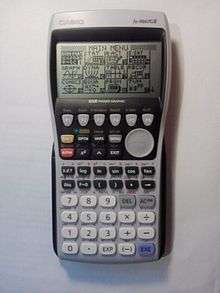Casio 9860 series
The Casio fx-9860G is a series of graphing calculators manufactured by Casio Computer Co., Ltd.
|
Casio fx-9860G SD | |
| Type | Programmable Graphing |
|---|---|
| Manufacturer | Casio |
| Introduced | 2005 |
| Calculator | |
| Entry mode | Infix, Mathematical |
| Display type | LCD Dot matrix monochrome |
| Display size | 128 x 64 pixels |
| CPU | |
| Frequency | 29 MHz |
| Programming | |
| User memory | 64 KiB |
| Firmware memory | Flash memory, 1.5 MiB (800 KiB for AU version) |
| External memory | Up to 2 GB for SD version with an SD memory card |
| Interfaces | |
| Connects to |
PC via one of:
|
| Other | |
Variants

There are several versions of the fx-9860G; the standard fx-9860G, often referred to as the 'vanilla' flavor, and the SD, AU and Slim versions.
- The AU version used to limit the amount of internal flash memory available to 800 Kb to meet Australian school regulations, although it has now been upgraded to 1.5MB.
- The SD variant comes with an SD expansion card slot, allowing read and write access up to 2 GB of memory on a SD memory card.
- The Slim version has a back-lit display, on-board help, and is designed as a clam-shell to minimize its size.
- The fx-9860GII and fx-9860GII SD became available in May 2009. These calculators have backlit displays and the Geometry (in user mem) and ECON2 apps preinstalled. They also have new mathematical functions.[1]
The usual fx-9860G and fx-9860G SD are marketed in France as Graph85 and Graph85 SD.
The French versions of the GII models are the Graph 75 and Graph 95. The Australian version of the GII is the fx-9860G AU PLUS.
Programming
The calculators can be programmed in different ways. The fx-9860G's come with a built-in BASIC-like interpreter (Casio BASIC), allowing the user to create simple and complex programs using built-in functionality.
The other method is to create an add-in. Add-ins are binary programs, executing directly on the calculator's CPU. CASIO has released two official add-ins, GEOMETRY and PHYSIUM. An SDK was released by CASIO in 22/01/2007, allowing users to create their own add-ins, though no support is provided for this by CASIO. The add-ins and the SDK are available for registered users at CASIO's website.
Add-ins and the SDK allow more powerful applications to be developed, and have been used to create an interpreter for the popular Multi-Platform Language for Calculators. After was created a lua interpreter (luaFX) and a new language called Malical for users who do not want to code in C or basic.
Recently an OnCalc C Compiler was released.
References
External links
| ||||||||||||||||
| |||||||||||||||||||||||||||||||||||||||||||||||||||


